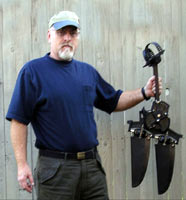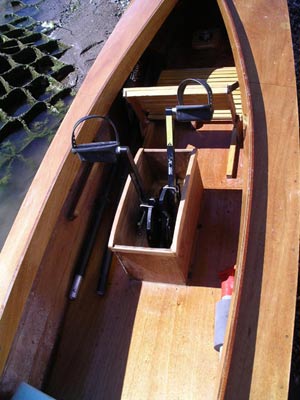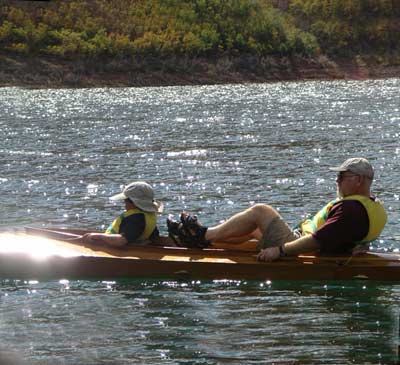It's All in the Legs
by Kellan Hatch
I have been haunting the internet for the past
couple of years looking for the ideal way to add pedal propulsion
to my sailing kayak/trimaran. I pop up on Yahoo groups from
time to time and annoy people with the topic. I think a lot
of people perceive pedal-powered boats as just plain wacky.
Maybe they associate them with those plastic paddlewheel atrocities
that you can rent at beach resorts. I don’t know, but
I had my own reasons for taking pedal propulsion seriously.
My first goal was to avoid at all costs the tyranny
of the internal combustion engine. A close second was to provide
an alternative to paddling. You’re wondering what I’ve
got against paddling. That’s the common solution for moving
sailing canoes and kayaks around when the wind dies, right?
Not for me. I have this… thing. I don’t even know
what to call it but it’s a condition in my arms and shoulders
that I’ve had since I was a kid, some sort of muscle/tendon
weirdness that very efficiently converts repetitive circular
motion into searing pain. Two hours of paddling equates to twenty
hours of paddling regret.

Pedaling under full steam
I considered electric propulsion: unnecessary
complexity and unwanted reliance on maintaining a battery charge.
I’ve done a lot of rowing lately too. It’s not as
painful as paddling but I really prefer to face forward whenever
possible. Oars aren’t really an option for this boat anyway;
there’s no room for them when the sailing outriggers are
attached. I’m intrigued by yulohs and sculling too, but
that’s still an arm thing and just isn’t very practical
for a kayak hull.
So my checklist always brought me back to pedal
power. And why not, they tell me that your legs have the strongest
muscles in your body. Legs exist for the sole purpose of locomoting.
Arms are meant for things like throwing rocks, rubbing sticks
together and peeling bananas. I maintain that your arms were
never meant for locomotion.
I’ve been scouring the internet for some
time and I think I’ve seen every pedal operated gizmo
out there. Many are massive, ungainly Rube Goldbergian contraptions
with belts and pulleys, chains and gears, cranks and universal
joints. They either use long drive shafts to get the power aft
or they sling a pylon and propeller under the hull, consequently
adding a couple of feet of draft to a boat that should only
draw a couple of inches. Some are fairly impressive feats of
engineering, but when it gets down to trying to buy one, most
turn out to be yet-to-be-marketed prototypes or the fevered
dreams of mad tinkerers, just over the horizon from being an
actual product that you can buy and install in YOUR boat. And
the ones that are on the market tend to be expensive, often
more than double the price of the boat itself.
 And
then there’s the Hobie
Mirage Drive. As close to proof of the existence
of God as you’ll find. If you haven’t seen this
thing, it’ll knock your socks off. Or at least it should.
No propeller. It’s driven by two smallish fins -Hobie
calls them sails- that sweep back and forth beneath the hull
as you pedal. It adds a little more than a foot to the draft,
but the sails fold neatly up against the hull for beaching.
In fact, they end up horizontal at the end of every stroke so,
get this, in extremely shallow water you can feather the sails
close to your hull for partial thrust. And it’s compact;
a single integrated unit that you can easily carry in one hand.
And
then there’s the Hobie
Mirage Drive. As close to proof of the existence
of God as you’ll find. If you haven’t seen this
thing, it’ll knock your socks off. Or at least it should.
No propeller. It’s driven by two smallish fins -Hobie
calls them sails- that sweep back and forth beneath the hull
as you pedal. It adds a little more than a foot to the draft,
but the sails fold neatly up against the hull for beaching.
In fact, they end up horizontal at the end of every stroke so,
get this, in extremely shallow water you can feather the sails
close to your hull for partial thrust. And it’s compact;
a single integrated unit that you can easily carry in one hand.
It’s so small you’d have no problem
stowing it on board if you wanted to remove it while sailing.
Another great thing about pedal drive is that
it frees your hands for things like steering, sailing and peeling
bananas. Hobie provides an optional sail rig for their Mirage
kayaks, so you can pedal, paddle or sail, or any combination
of those – all three at once if you’re coordinated
enough. I’m not.
I had the opportunity to test drive a Hobie Mirage
kayak a few months ago and I knew that I had finally reached
the Promised Land. I could easily maintain 3-1/2 to 4 knots
for an indefinite period. And it was fun. And easy; virtually
no technique to learn. The pedaling motion seemed very organic
and natural. It was a comfortable motion. My hat’s way,
way off for Greg Ketterman, Hobie designer and inventor of the
Mirage Drive.
The obvious hurdle for retrofitting the Mirage
drive onto another boat was that the drive was designed specifically
to power a sit-on-top kayak. It just drops through a big, open,
wet slot in the bottom of the boat. It appeared that, even if
I could get my hands on a Mirage Drive, there would be no way
of sealing it to keep the water outside my hull.
Then I realized that it’s essentially the
same problem as putting a daggerboard in a trunk. I could mount
the Mirage Drive in a well in the floor of my cockpit. I just
had to make sure that it was deep enough to keep the water from
flooding into the cockpit, plus a few inches of safety margin.

The trunk with drive in place
I went to the local Hobie dealer to see if he
could order a Mirage Drive for me and he actually sold me one
right off his stockroom shelf (a bit reluctantly – he’d
have preferred to sell a boat to go along with it). I had already
worked out the installation details on paper.
I think it was the same day I bought my drive
that I found out that a member of the Yahoo
Proa File group, Gary Lepak was also in the process
of mounting a Mirage Drive in a small proa that he’s building.
Ok, I have to make a bit of a guilty confession here. Gary lit
the fire under me to get mine on the water first. A bit childish,
I know, but thanks to Gary for the added inspiration.
Anyway, a few days later I had the thing installed
and ready to test. Anyone who’s cut a hole in the bottom
of their boat can attest to the degree of psych required to
make the first cut. You stand there, tool in hand, feeling like
you’re on the verge of committing to a DIY appendectomy
or something. I built an eight-inch deep trunk around the hole.
Said hole is actually a diamond-shaped slot that fits closely
around the drive’s nether regions. My boat typically draws
about 3 inches, but I made the trunk about as deep as I could
without interfering with pedaling. That brought it almost up
to the cockpit edge, which will certainly help if I find myself
in need of bailing out. Anyway, by the next day the fillets
had set up and I could see no reason not to try it out, so I
loaded everything onto the roof rack and packed the family into
the pickup for a drive up to the nearest reservoir.
The boat in question is a kit-built CLC Mill Creek
16.5 open cockpit kayak. I’ve rigged this boat to also
be configured as a sailing trimaran (see my article: A
Curious Boat for Questionable Adventures in the
Duckworks archives) but it strips down to its basic paddling
hull, leaving only a couple of bronze cleats to indicate that
there’s anything more than meets the eye. I built a kick-up
rudder that’s operated by means of a push-pull tiller.

Easily beached with drive installed
Once the boat was in the water I dropped the Mirage
Drive into the well, flipped the latch bolts and I was ready
to pedal.
Hobie claims that one man pedaling a Mirage Drive
is equivalent to two men paddling. They even have a movie on
their website of a one-on-two
tug-of-war against two strong paddlers. I’ll
have to take their word for it, but I can tell you that I was
sure getting a lot of forward movement for the amount of energy
I was putting into it. On my initial test I pedaled for about
two hours, stopping only to pick up and drop off kids, without
any appreciable fatigue. I clearly could have kept it up for
hours. I’d say the effort needed to maintain around 3-4
knots (I haven’t bought the optional speed indicator yet,
so I’m guessing based on how fast I was passing surface
bubbles and floaters) is about the same as pedaling my mountain
bike up a slight incline. As far as I could tell, my Mill Creek
seemed to move about as well as the stock Hobie kayak. When
I test drove the Hobie boat a few months back, speed indicator
attached, I could easily stay in the 3 ½ to 4 knot range.
I maxed out around 5 ½ , but it took extreme effort to
keep up that kind of speed. 3 ½ knots will get me anywhere
I need to go.

Skipper in front, engine in back
There’s no room in the trunk for the turnbuttons
that Hobie uses to lock the Mirage Drive into their boats. The
trunk is big enough as is, and that would add unwanted inches
to its width, so I opted for a slide bolt arrangement. I was
hoping to find something in stainless steel but ended up with
a pair of brass cabinet latches.
I do have a few minor negatives to report:
First of all, there’s no reverse gear, so
I use a paddle when I feel the urge to go backwards.
Also, the sails tend to whack against the flat
bottom of the Mill Creek’s hull. No big deal, but kind
of annoying. I quickly learned to moderate my stroke to eliminate
the thumping. I’m not sure why, but this slightly reduced
stroke also seems to be slightly more powerful. Probably something
to do with reducing vortices between the sails and the hull
or something.
Finally, the pedaling posture raises the boat’s
center of gravity and reduces its stability. Fortunately, the
Mill Creek has a very wide beam for a kayak, so stability isn’t
nearly as much of an issue as it would be with a narrower hull.
I may build a pair of small stabilizing outriggers like I’ve
seen used on some prop-driven HP boats, just for some additional
confidence on rough water and longer crossings. Of course, it’s
a non-issue when I’m in trimaran configuration.
All in all, the trial run went as well as I could
have hoped for. I was very, very pleased with the result –
in fact, I can’t remember the last time I was this pleased
with ANYTHING.
The following weekend I was on the water again,
this time with the goal of getting good enough data to calculate
my pedaling speed. I made a five-mile run, part of which provided
very accurate time and point-to-point distance measurements.
With the use of a topo map I was able to determine that the
return leg of the trip averaged 4.4 MPH, which works out to
just a little more than 3.8 Knots if we’re keeping it
nautical. Not bad.
I’d like to cover a lot more distance on
another excursion before the weather turns too cold. I’m
hoping to make a round trip out and back to an island in the
Great Salt Lake, about 15 miles of open water, if I can get
way for a full day. I should probably build those stabilizers
first.
I’ll let you know how it goes.

Follow-up

Approaching Fremont Island
My trip to Fremont Island in the Great Salt Lake
went off without a hitch. It was a glassy-smooth day; the kind
I've cursed a hundred times when I was trying to sail out there,
but ideal for this pedal-only shakedown. The whole excursion
took about five hours, including a stroll on the island before
I headed back. The Mirage Drive performed very well in every
respect. My average speed (although I don't have any kind of
accurate measurement) was definitely less than on my initial
tests. I'm not sure if this was simply because it was a longer
trip and I was being careful to keep plenty of stamina in reserve,
or if additional friction from the denser water - four times
the salt content of seawater - had something to do with it.
Probably both. The main thing is that I proved to myself what
I can expect from the Mirage. In combination with my sail rig
it should take me just about anywhere I want. And I can't tell
you how good it felt to get a good night's sleep rather than
spending the night nursing throbbing arms.
There's another island about 20 miles out (40
miles round trip). I'm hoping to make that a destination for
an overnighter next year when I've finished upgrading my sail
rig.


